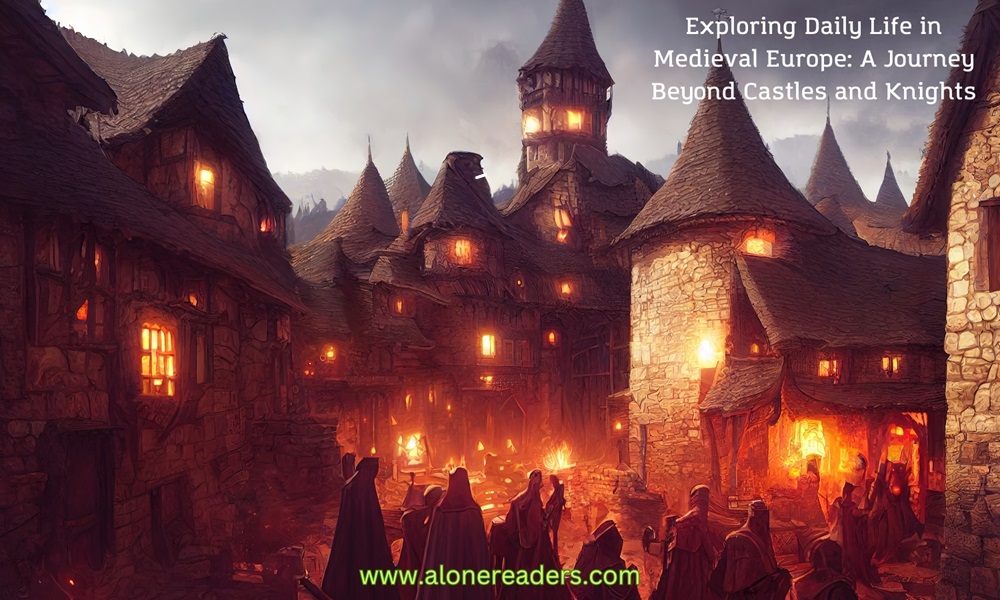
Medieval Europe, a time often romanticized for its grand castles and valiant knights, was much more than these iconic symbols. This era, stretching roughly from the 5th to the late 15th century, was a period of profound social, economic, and cultural transformation. To truly understand this era, one must look beyond the fortified walls of castles and the clashing of knights' armor, delving into the everyday lives of the common people and the rich tapestry of medieval society.
Life in Medieval Europe was predominantly rural. The majority of the population were peasants who lived in small villages and worked the land. Their lives were governed by the agricultural calendar, with the planting and harvesting seasons dictating their daily routines. Peasants typically lived in simple homes made of wood, wattle, and daub, with thatched roofs. These homes were small, often consisting of a single room that served as a living area, kitchen, and bedroom. The hearth was the center of the home, providing warmth and a place to cook.
Agriculture was the backbone of the medieval economy, and the techniques used were relatively primitive by today's standards. Crop rotation and the three-field system were common, allowing for more efficient use of land. Peasants would grow a variety of crops, such as wheat, barley, oats, and rye, alongside maintaining vegetable gardens for their own sustenance. They also raised livestock, including pigs, chickens, and sheep, which provided meat, eggs, and wool.
The feudal system played a central role in medieval society. This hierarchical system saw peasants working the land owned by a lord. In return for protection and the right to work the land, peasants owed various dues, including a portion of their harvest. This feudal relationship was not just economic, but also social and political, with the lord holding significant power over the lives of his vassals and serfs.
Religion was a cornerstone of medieval life. The Church held immense influence, not only spiritually but also politically and socially. The local parish church was a focal point of community life, serving as a place of worship, a social gathering place, and often as a center for education and charity. Festivals and saints' days punctuated the calendar, providing respite from the daily grind and an opportunity for celebration and community cohesion.
Education and literacy were largely confined to the clergy and the nobility, but there were exceptions. Monasteries and, later, universities emerged as centers of learning, preserving and transmitting knowledge. The invention of the printing press towards the end of the medieval period was a pivotal moment, gradually making books more accessible and fostering a slow increase in literacy rates.
The medieval period was also a time of significant cultural development. Art, music, and literature flourished, with the sponsorship of the Church and the nobility playing a crucial role. Gothic architecture, characterized by its pointed arches, ribbed vaults, and flying buttresses, was a defining feature of this era. In literature, works like Dante's "Divine Comedy" and Chaucer's "Canterbury Tales" provide a window into the medieval mindset and society.
Trade and commerce experienced a revival during the later medieval period, leading to the growth of towns and a burgeoning middle class of merchants and artisans. Markets and fairs were common, allowing for the exchange of goods ranging from local produce to exotic imports. The growth of trade guilds helped regulate and organize various trades, setting standards for quality and fair business practices.
The role of women in medieval society was complex and varied. While they were often limited by societal norms and legal restrictions, many women played crucial roles in the family, economy, and even in politics. Noblewomen could wield significant influence, while peasant women worked alongside men in the fields, markets, and homes. The medieval period also saw the rise of remarkable women like Eleanor of Aquitaine and Hildegard of Bingen, who left lasting impacts on their world.
Medieval cuisine was a reflection of one's social status. The diet of the nobility was rich and varied, featuring meat, fish, and spices from distant lands. In contrast, the peasant diet was more humble, consisting mainly of bread, porridge, and vegetables. Brewing and baking were important activities, and the consumption of ale and beer was common, as these were safer to drink than water.
Life in medieval Europe was not without its challenges. Plagues, such as the Black Death, decimated populations, while wars and conflicts, like the Hundred Years' War, brought devastation. However, these hardships were also catalysts for change, leading to shifts in social structures and the eventual decline of feudalism.
In conclusion, life in medieval Europe was a tapestry of experiences, far richer and more complex than just the romanticized images of castles and knights. From the daily struggles and joys of the peasantry to the cultural and intellectual achievements of the period, this era laid the foundations for many aspects of modern Western society. Understanding this period requires looking beyond the stereotypes and delving into the real lives of those who lived through these transformative centuries.